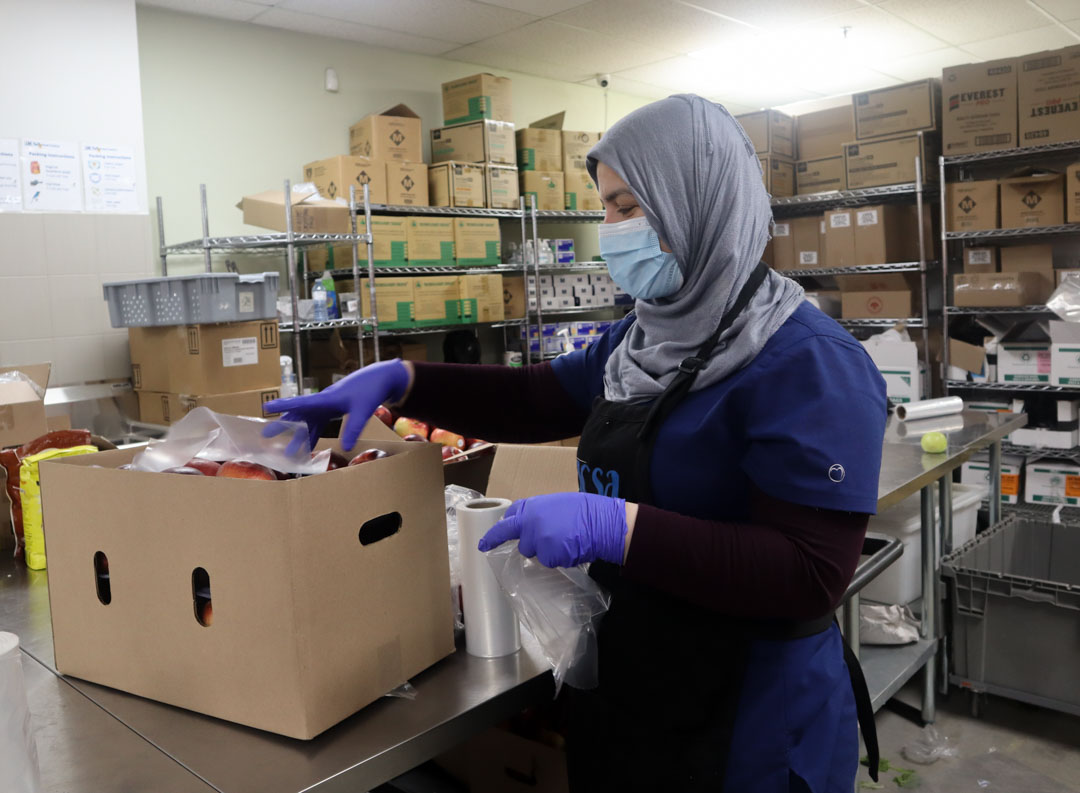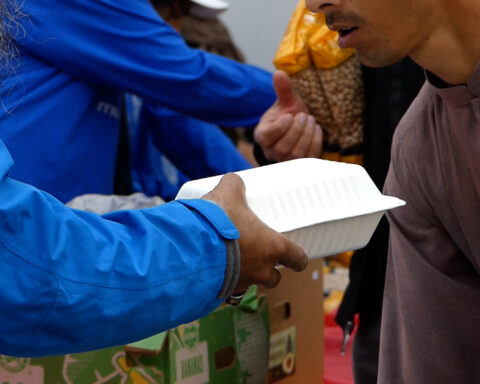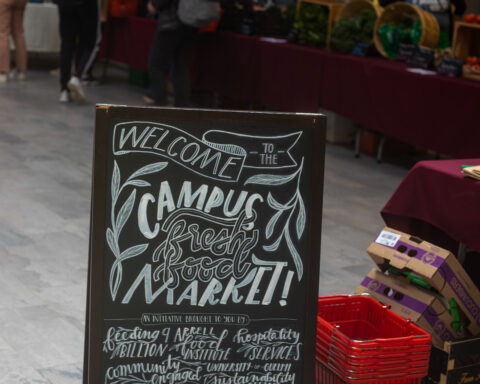“[It] is a heartbreaking [situation] for people in the city right now, people are running around looking for food.”
Ilham Saydna, a community engagement coordinator at Daily Bread Food Bank who identifies priority areas that suffer from food insecurity in Toronto and surrounding areas, said that she has seen a drastic increase in clients who travel far to access food banks. One of the regions seeing a rise in clients who come from other cities includes Scarborough.
In pre-pandemic years, the food bank saw an average of 65,000 clients a month. In March 2023, the Daily Bread and their food bank network number served 270,000 clients accessing their services.
The high inflation prices, influx of Ukrainian refugees, and people living in food deserts in some areas have all contributed to high visits to food banks across the city, she said.
Food insecurity continues to heighten following the pandemic due to inflation rates creating a higher cost of groceries, which are up almost 10 per cent according to Trading Economics. This has also led to an increase in food deserts, which are areas where it’s difficult to buy affordable and quality groceries. Combined, these issues have led those who are food insecure to travel far to find affordable meals and groceries.
She believes Scarbrough might be a popular area for clients because of the mobilization effort to serve the region.
Before Scarbrough became a district with access to many different food banks, it was a bit of a food desert and a high-priority area with people travelling far to access food banks. It has now become one of the most popular areas that Saydna sees people visit to go get meals, especially during the pandemic.
“Scarborough community stepped up. They are the best in the city of Toronto. During COVID and forward, they [were] willing to take any numbers. They’re not saying no not turning people away. You [had] some organizations that are turning people away in the city,” expressed Saydna.
The Daily Bread Food Bank is one of Canada’s largest food banks, with locations across Toronto as well as partnerships with other organizations to help distribute supplies to other food banks. The organization also researches and recommends policies around the issue of food scarcity.
The organization releases an annual “Who’s Hungry” report every year on poverty and food insecurity in Toronto which has become an important resource for the government and non-profit organizations.
Scarborough food banks see increase in clients
“We have clients coming from Brampton, Mississauga, [and] Pickering. We have international students who are enrolled in programs, even in colleges in Sarnia and Belleville,” said Suman Roy, founder and CEO of the Scarborough Food Security Initiative.
Roy started Feed Scarborough in 2018 as a small organization handing out food hampers. During the pandemic in 2020, his organization grew rapidly by addressing food insecurity in all parts of Scarborough.
The organization provides various programs, such as mobile food programs and community gardens. They currently have five different food bank locations across Scarborough and serve many newcomers.
According to their 2022 Impact Report, the organization saw a rise in clients, serving 6000 community members a week, and numbers continue to rise in 2023.
Five different organizations that operate food banks in Scarborough have claimed to observe some of their clients coming from outside of the Scarborough area, including the Scarborough Food Security Initiative, Takbeer Food Bank, Muslim Welfare Canada, Agincourt Community Services Association (ACSA), and The Salvation Army Scarborough Citadel.
Although Scarborough food banks have yet to have exact data on how many clients outside of Scarborough they serve, as recording that data has yet to be a priority, most food banks observe clients coming from many different areas through addresses provided by clients during registration for their client IDs.
“Stigma is a big factor in it. People are not comfortable telling somebody that they are where they live, and they’re coming to access,” said Roy.
Additionally, Roy explains that many food banks do not collect data like this for privacy reasons.
Factors in choosing a food bank
When it comes to why individuals might go out of their way to use food banks in Scarborough, Roy found that the reason is primarily due to preference on how different food banks operate.
The time that the food banks open and close, as well as the grocery model they may incorporate, are factors he has seen as to why people would want to visit their food banks and others similar to them.
Feed Scarborough has some of their food bank locations open during the weekend, like their Cliffside food bank, making it more accessible to individuals. Others are open until later in the evening, like their Rouge Park Food Bank, which only closes at 6:30 p.m.
Food banks across Toronto all run on different hours of operation, with some open late in the evening and weekend, while others do not.
“I think one of the biggest reasons that we have found of people coming from Brampton, … [is] timing and the accessibility to the food banks. For example, the ones we see most out of Scarborough people are in [our] Rouge Park [location], which is open Tuesday to Saturday and from noon till late evening,” said Roy.
The ACSA food bank is a prominent food bank in Scarborough, serving 5000 clients weekly.
“When I see an increase in numbers, it makes me feel sad. And it breaks my heart. Because when I see the people are more in demand on food, and on a weekly basis, it’s increasing — we are having less food than usual,” said Souraya Awad, the ACSA program coordinator on the growing number of people accessing the food bank.
Awad has observed that many clients outside Scarborough use the ACSA food bank.
She believes that the grocery store model they offer, which carries a variety of products, such as diapers, toiletries, and different cultural foods, play a big part in people traveling far for the ACSA food bank.
The grocery model works by food banks providing clients credits, or points, and the clients pick items they want to get with the points/credits they are allotted, which is different from food banks that provide ready-made hampers with the food items they have available.
“It makes it easy for the client, as if I’m giving you back your dignity and the money. And you will be your own person as if you are going to a grocery store and choosing what you like to eat, what you don’t like to eat, and what you need at home,” explained Awad.
Michael J. Widener, an associate professor and Canada Research Chair in Transportation and Health at the University of Toronto, researches the different ways people can access food.
He is currently conducting research on why people travel far for food banks with the Daily Bread Food Bank and believes the grocery model is definitely one of the factors why people might travel outside of their area for different food banks.
“People have different preferences,” explained Widener. “So, if your neighbourhood food bank is a hamper model, you may bypass it to go to a choice model.”
Issues of accessibility to food banks
However, there are many other factors, especially when it comes to more immigrant groups, as to why people travel far for food banks.
For newcomers coming from different areas to Scarborough, it could be because the food bank has a predominantly similar culture to that individual, which can evoke a feeling of safety and comfort.
“If it’s a newcomer and they know people at this food bank speak Mandarin and [other] ones that don’t, then they might go to the one where they can more easily communicate,” said Widener.
In Scarborough, one in five residents have recently arrived in Canada.
Another factor, as Widener explains, is how accessible transportation is near the individual.
“You might be very close to food bank A. But if you’re also close to [the] subway that goes up to food bank B, and it’s further away, you might choose to go to food bank B, because you don’t want to take the bus [to food bank A],” said Widener.
A study from the Findings Journal that analyzed how transit accessibility to food banks changed during the pandemic, found that before new food bank locations opened up during the pandemic and new changes were made to the transit system, it would take 30 minutes for the majority of the population in Toronto to get to a food bank.
However, during the pandemic, when new food banks opened, their locations tended to be more accessible, especially to those from areas with lower socio-economic means.
Saydna, a coordinator at Daily Bread Food Bank, added that the trend of individuals travelling far to different food banks is, “not unique to Scarborough,” and more of a, “phenomenon that is [seen] across the city.”
“People are running around looking for food everywhere. So if the food bank is near where they go to school, but they actually live in Brampton, they just take the food while they’re there,” said Saydna.
She believes we need to do better with the current situation around food insecurity, as well as collecting data to know which communities are dealing with food scarcity so the government can create “target policies to reduce hunger.”
According to the Public Health Agency of Canada, not being able to access food or live in food insecure households is considered a severe health problem in the country, which can be linked to poor mental health, early mortality, and several other health risks.
“The government needs to do something at this point because it’s just unacceptable what’s happening,” expressed Saydna.
Muzna is a journalism student at the University of Toronto and is an aspiring investigative journalist. She currently lives in Scarborough and focuses on reporting stories about visible and marginalized communities. Her favourite medium to work with is audio.





